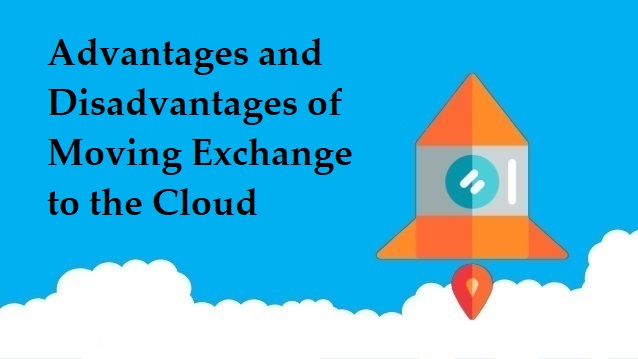Top 4 Advantages and Disadvantages of Moving Exchange to the Cloud
Exchange Server is used by multiple organizations to support several business requirements and it is available as On-Premise Exchange and Office 365. Due to the growing popularity of Offline-service Office 365, users prefer to move from Exchange to the Cloud. Office 365 offers easier to manage Exchange Service and eliminates capital cost associated with running the Server Edition & management overhead associated with it. Along with good points for Migration from Exchange to Cloud, it also has some bad points. In this blog, we will be discussing the advantages & disadvantages of moving Exchange to Cloud to help the user avoid headaches in the end.

Advantages of Moving Exchange to Cloud
Increased Reliability
Moving Exchange to the Cloud means the emails will be accessible without any interruptions and headache of having to maintain On-premise hardware. The cloud vendors are known for providing higher uptime guarantees. However, users should properly plan the migration process in order to avoid downtime in the transition.
Better Security
Using Exchange Server in the cloud means lesser machines where Anti-virus software needs to be installed, upgraded, or tested. IT department applies updates automatically & focusses more on troubleshooting issues, providing better security for Exchange Server and confidential data involved. Any small/large businesses can have access to enterprise-level security. Users should always enquire about security standards that the vendor provides before moving to cloud.
Reduced Cost
Another benefit of moving Exchange to the cloud may involve high cost initially but in the long term, organizations will save money due to reduced capital expenditures on servers and lowers the cost of operation with only a few staff involved. Less time spent on monitoring & resolving problems means more time spent on revenue-generating projects.
Increased Flexibility
As deploying Exchange Server in Cloud requires fewer machines, the IT department provides better flexibility in determining new and improved solutions to apply in the Cloud Environment. Increased flexibility will not only lead to higher productivity but also more employee satisfaction.
Important Note: If you are planning to migrate Exchange On-Premise to Exchange Online, then you are suggested to opt for this third-party utility. It provides you a simple and reliable way to export your complete Exchange mailbox data directly. There are some additional features provided by the software as well which makes the entire job effortless. You can download and try the free download version of the tool.
Disadvantages of Moving Exchange to Cloud
Loss of Control
When the company moves into a cloud infrastructure, control is lost to some extent as the environment is being hosted rather than On-Premise. Any upgrades, configuration, or changes cannot be made by the company, as it will be done by the vendor providing Exchange server in the cloud. Hosted Environment may have restrictions on some files like XML for security concerns. The organization that needs to work with XML files on daily basis may not find hosted Exchange a suitable solution.
Upfront Costs
Moving Exchange Server to the Cloud can lower capital costs for long terms, but a business also needs to ensure that it can handle all the short-term costs involved. It includes finding best possible solution structures, assigning resources for planning, performing migration etc. Sometimes, Hosted Exchange may involve additional costs if resources other than employees are managed through Exchange.
Increased Bandwidth
The organizations using hosted Exchange, especially highly collaborative ones may need to double or triple their bandwidth upon moving to Cloud Environment. Increased bandwidth means more megabits, which can be costly. On-Premise Exchange has the ability to send/receive emails internally with a LAN while in hosted Exchange, no internet means no emails can be communicated both internally & externally.
Conclusion
In the blog, we have discussed the pros and cons of moving Exchange to Cloud. There are two possible ways for migration of Exchange to Cloud i.e. either transfer data via PST file or use a third-party tool for direct migration. Though migrating from On-Premise Exchange Environment to Hosted Exchange infrastructure provides several benefits like more flexibility, reduced expenditures, security etc., it also comes with some disadvantages. It is recommended that Organizations consider all the aspects like migration plan, security standards provided by Cloud vendor etc. before moving Exchange to the cloud.


